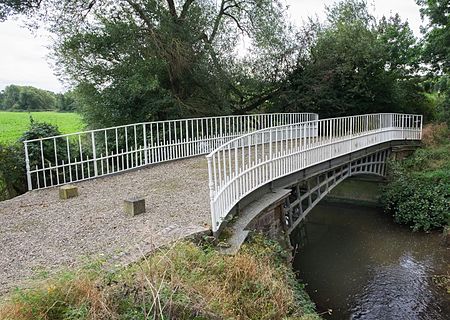Cantlop Bridge

Cantlop Bridge is a single span cast-iron road bridge over the Cound Brook, located to the north of Cantlop in the parish of Berrington, Shropshire. It was constructed in 1818 to a design possibly by Thomas Telford, having at least been approved by him, and replaced an unsuccessful cast iron coach bridge constructed in 1812. The design of the bridge was innovative for the period, using a light-weight design of cast-iron lattice ribs to support the road deck in a single span, and appears to be a scaled-down version of a Thomas Telford bridge at Meole Brace, Shropshire. The bridge is the only surviving Telford-approved cast-iron bridge in Shropshire, and is a Grade II* listed building and scheduled monument. It originally carried the turnpike road from Shrewsbury to Acton Burnell.
Excerpt from the Wikipedia article Cantlop Bridge (License: CC BY-SA 3.0, Authors, Images).Cantlop Bridge
Cantlop Bridge,
Geographical coordinates (GPS) Address External links Nearby Places Show on map
Geographical coordinates (GPS)
| Latitude | Longitude |
|---|---|
| N 52.6518 ° | E -2.7148 ° |
Address
Cantlop Bridge
Cantlop Bridge
SY5 7DD
England, United Kingdom
Open on Google Maps










